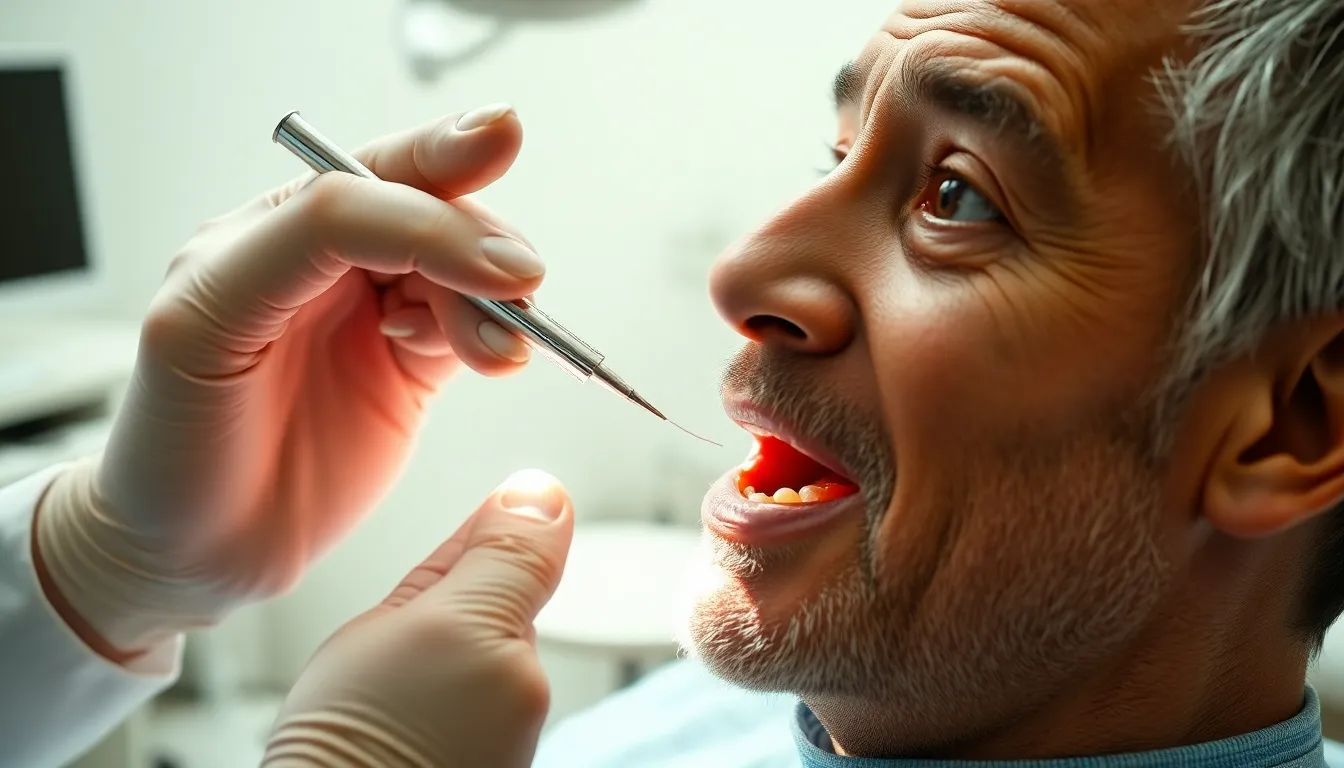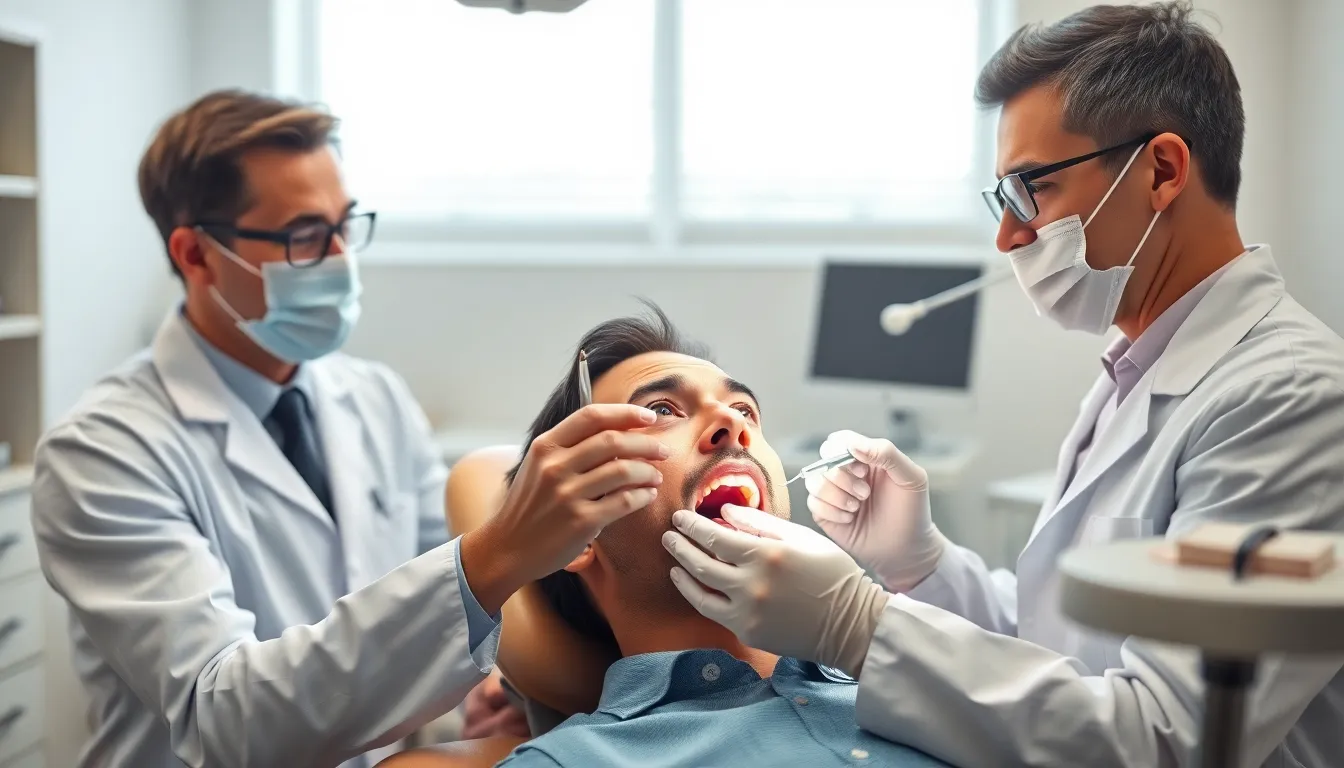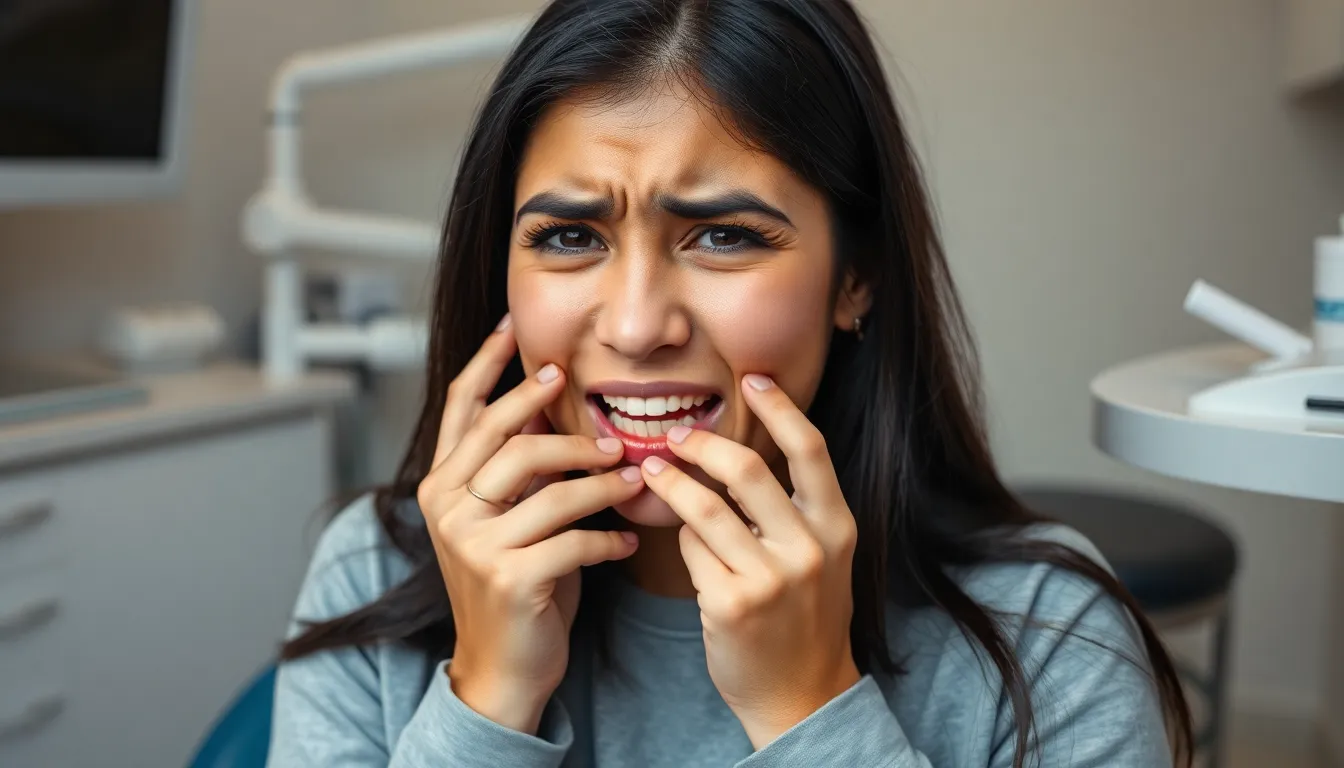Dealing with tilted teeth but not sure what your options are? You’re not alone. Millions of Americans struggle with misaligned teeth that affect both their smile confidence and oral health.
Tilted teeth occur when teeth grow at an angle instead of straight, creating alignment issues that can impact your bite and overall dental function. While they might seem like just a cosmetic concern, tilted teeth can lead to more serious problems including uneven wear, difficulty cleaning, and increased risk of gum disease. The good news? Modern dentistry offers several effective answers that can help straighten your smile without traditional metal braces.
What Are Tilted Teeth?
Tilted teeth refer to teeth that grow at an angle instead of straight up from the gums. This dental condition occurs when teeth don’t emerge properly aligned with adjacent teeth, creating gaps, overlaps, or crooked appearances in your smile.
Common Causes of Dental Tilting
Dental tilting stems from several distinct factors that influence tooth positioning. Genetics plays a primary role, as inherited jaw structure and tooth size often predetermine alignment issues. Childhood habits like prolonged thumb-sucking or pacifier use can push teeth out of their natural position. Losing teeth without timely replacement creates space where adjacent teeth drift or tilt into the gap. Gum disease damages the supporting structures of teeth, allowing them to shift position over time. Trauma from accidents or injuries may knock teeth out of alignment, while grinding and clenching (bruxism) applies excessive force that gradually tilts teeth.
Dr. Harris recently treated a patient named Sarah who had perfectly straight teeth until losing a molar in her twenties. “By the time Sarah came to see me, the teeth on either side of the gap had tilted significantly toward the empty space,” Dr. Harris explains. “This tilting created additional problems with her bite and made proper cleaning difficult.”
Identifying Tilted Teeth in Your Smile
Tilted teeth display exact characteristics that differentiate them from other dental alignment issues. Visual inspection reveals teeth that lean to one side rather than standing perpendicular to the gum line. Bite function changes when teeth tilt, often creating areas where teeth don’t meet properly during chewing. Food frequently becomes trapped between tilted teeth, making them more difficult to clean with normal brushing and flossing. Uneven spacing appears between teeth as they lean into open areas. X-rays provide the clearest evidence of dental tilting by showing the roots’ orientation beneath the gum line.
Health Implications of Tilted Teeth

Tilted teeth create far more than just cosmetic concerns. They present serious health challenges that affect your overall oral wellness and can lead to progressive dental problems if left untreated.
Impact on Oral Hygiene
Maintaining proper oral hygiene becomes significantly more difficult with tilted teeth. The irregular alignment creates hard-to-reach areas where your toothbrush and floss can’t effectively clean, leading to increased plaque buildup and bacterial growth. Food particles frequently get trapped between crooked or overlapping teeth, creating perfect environments for decay-causing bacteria to thrive. Patients with tilted teeth face a higher risk of developing dental caries (cavities) and periodontal disease due to these cleaning challenges.
Dr. Todd B. Harris notes, “I’ve seen countless patients struggle with recurring cavities even though good brushing habits simply because their tilted teeth create cleaning blind spots they can’t reach with conventional methods.”
The excessive plaque accumulation along the gumline of tilted teeth often leads to inflammation, bleeding, and eventually gum disease. Regular brushing requires extra attention and specialized techniques, and even with diligent care, professional cleanings become more crucial for maintaining oral health when teeth aren’t properly aligned.
Effects on Jaw Alignment and Function
Tilted teeth significantly impact your jaw function and overall bite mechanics. When teeth don’t align properly, uneven pressure distributes across your mouth during chewing, causing excessive wear on certain teeth while others remain relatively untouched. This imbalance creates abnormal wear patterns, prematurely damaging tooth enamel and exposing sensitive inner layers.
The misalignment from tilted teeth commonly causes malocclusion (improper bite), placing substantial stress on your jaw joints and muscles. Many patients experience temporomandibular joint (TMJ) disorders characterized by jaw pain, headaches, earaches, and clicking or popping sounds when opening or closing their mouth. In severe cases, jaw locking can occur, dramatically affecting daily activities like eating and speaking.
Sarah, the patient mentioned earlier, experienced increasingly frequent tension headaches as her tilted teeth progressively worsened her bite alignment. “At first, I thought my headaches were stress-related,” she explained. “It wasn’t until my dentist pointed out how my jaw was compensating for my tilted teeth that I made the connection.”
Chewing efficiency decreases with tilted teeth, potentially affecting nutrition and digestion. Speech clarity may also become impaired in more severe cases, as proper tongue placement depends partly on correct teeth positioning. Correcting the alignment improves jaw biomechanics and reduces the discomfort associated with TMJ disorders, allowing for more natural oral function.
Treatment Options for Correcting Tilted Teeth

Modern dentistry offers several effective answers for correcting tilted teeth, each with unique advantages depending on your exact needs and preferences. These treatments range from traditional orthodontic approaches to more cosmetic answers that can transform your smile.
Traditional Braces
Traditional braces remain one of the most reliable methods for correcting severely tilted teeth. Metal brackets attach to each tooth’s surface while connecting wires apply consistent pressure to gradually shift teeth into proper alignment. They’re particularly effective for complex cases where teeth are significantly angled or rotated. Many patients experience noticeable improvements within 6-8 months, though complete treatment typically takes 18-24 months. Dr. Harris notes, “Traditional braces give us precise control over tooth movement, allowing us to address even the most challenging alignment issues that other treatments simply can’t correct.” Michael, a 35-year-old patient, postponed treatment for years due to concerns about wearing metal braces as an adult but was amazed by how quickly his severely tilted molars responded to treatment, resolving his chronic jaw pain within months.
Clear Aligners
Clear aligners like Invisalign® offer a discreet alternative for correcting mild to moderate tilting without the visibility of traditional braces. These custom-made transparent trays fit snugly over your teeth and apply gentle, consistent pressure to guide them into proper position. Most patients wear each set of aligners for 1-2 weeks before progressing to the next set in the series. Treatment typically requires wearing aligners for 20-22 hours daily, removing them only for eating and oral hygiene. Jessica, a marketing executive, chose clear aligners to correct her tilted front teeth before an important industry conference. “I appreciated that most people couldn’t even tell I was undergoing orthodontic treatment during important client meetings,” she reported after completing her 14-month treatment plan.
Dental Crowns and Veneers
Dental crowns and veneers provide cosmetic answers for mildly tilted teeth without actually moving them. Veneers are thin porcelain shells custom-crafted to cover the front surface of teeth, instantly creating the appearance of proper alignment. Crowns completely encase the visible portion of a tooth, restoring both appearance and function when tilting is accompanied by structural damage. Dr. Harris explains, “For patients with minor tilting who want immediate results, veneers can transform a smile in just two appointments without months of orthodontic treatment.” These restorative options typically last 10-15 years with proper care and maintenance. Robert, a wedding photographer, opted for porcelain veneers on his front four teeth that had tilted slightly over time. His treatment was completed in just three weeks, allowing him to feel confident behind and in front of the camera at upcoming events.
Prevention Strategies for Dental Tilting

Preventing tilted teeth is much easier than treating them once they’ve shifted out of alignment. The following approaches help maintain proper tooth position and reduce the risk of dental tilting that could lead to more serious oral health complications.
Regular Dental Checkups
Dental checkups serve as your first line of defense against tooth tilting. Professional evaluations every six months allow dentists to spot early signs of shifting teeth before they develop into more serious alignment problems. During these visits, your dentist examines the stability of each tooth, checks for signs of grinding, and evaluates your bite alignment to catch potential issues. Dr. Todd B. Harris emphasizes, “Many of my patients don’t realize their teeth are starting to tilt until we point it out during routine exams—catching these changes early typically means simpler interventions and better outcomes.”
Proper Oral Care Habits
Daily oral hygiene practices directly impact tooth stability and help prevent tilting. Brushing thoroughly twice daily and flossing once daily removes plaque that can contribute to gum disease, a leading cause of tooth mobility and subsequent tilting. Antibacterial mouthwash reduces harmful bacteria that affect gum health and periodontal support structures.
One patient, Michael, maintained perfect alignment for years after orthodontic treatment by following a strict oral care routine. “After investing in braces as a teenager, I became diligent about my dental routine,” he explains. “Twenty years later, my dentist attributes my stable tooth positions to consistent cleaning habits that preserved my gum health.”
For optimal prevention, incorporate these exact habits:
- Brush with a soft-bristled toothbrush using gentle circular motions
- Clean between teeth daily with floss or interdental brushes
- Rinse with an antimicrobial mouthwash to support gum health
- Replace your toothbrush every 3-4 months for effective cleaning
Addressing Teeth Grinding
Bruxism places excessive pressure on teeth and commonly causes them to shift or tilt over time. Using a custom-fitted nightguard distributes grinding forces evenly across your teeth, protecting them from the concentrated pressure that leads to movement. Pay attention to morning headaches, jaw soreness, or worn tooth surfaces—these symptoms indicate grinding that requires intervention.
Lisa, a marketing executive with a high-stress job, noticed her right molar starting to tilt inward. “My dentist identified nighttime grinding as the cause and fitted me for a custom mouthguard,” she recalls. “Not only did this stop the tooth from tilting further, but my morning headaches disappeared within weeks.”
Your dentist can create a custom nightguard that fits your exact bite pattern for maximum protection. Some patients also benefit from stress-reduction techniques like meditation or physical therapy to address the underlying causes of teeth grinding.
When to Seek Professional Help for Tilted Teeth

Consulting a dental professional becomes necessary when your tilted teeth interfere with daily function or cause persistent discomfort. Many patients initially dismiss minor tilting as merely cosmetic, but Dr. Todd B. Harris emphasizes that “even slight misalignment can eventually lead to important oral health complications if left unaddressed.” You’ll want to schedule an evaluation if you experience problems biting or chewing food properly, as misaligned teeth often create inefficient chewing patterns that can lead to digestive issues.
Speech difficulties represent another clear indicator that professional intervention is needed. Teeth play a crucial role in proper pronunciation, and tilted teeth frequently cause lisping or whistling sounds during conversation. Jane, a 42-year-old patient, recalled how her gradually tilting molars created embarrassing speech patterns: “I avoided important client presentations because I couldn’t pronounce certain words clearly. After treatment, my confidence in professional settings returned completely.”
Jaw pain or popping sounds when opening or closing your mouth signal potential TMJ complications related to dental misalignment. These symptoms typically worsen over time and may eventually lead to chronic headaches or facial discomfort. Severely misaligned teeth that visibly affect your smile or oral function warrant immediate professional attention, as they often indicate underlying structural issues requiring comprehensive treatment plans.
Self-esteem issues stemming from dental appearance shouldn’t be dismissed as merely vanity concerns. Psychological well-being significantly impacts overall health, and research indicates that dental appearance affects social interactions and professional opportunities. A dental evaluation provides valuable peace of mind even for minor tilting concerns, as early detection often allows for simpler, less invasive correction methods.
While minor teeth tilting might not always require immediate intervention, professional assessment remains essential for determining whether the condition could potentially worsen or cause long-term functional problems. Dr. Harris recommends scheduling a consultation when you first notice changes in tooth positioning rather than waiting until symptoms become severe or irreversible damage occurs.
Conclusion
Tilted teeth may seem like just a cosmetic concern but they represent a important oral health challenge that deserves attention. With modern dentistry offering answers from clear aligners to traditional braces you don’t have to live with the discomfort or complications that misaligned teeth create.
Taking action early can prevent more serious issues like TMJ disorders recurring cavities and gum disease. Whether you notice difficulty cleaning between teeth jaw pain or simply feel self-conscious about your smile it’s worth consulting with a dental professional.
Remember that prevention through regular checkups proper oral hygiene and addressing habits like grinding is your best defense. Your perfectly aligned smile isn’t just about aesthetics—it’s a foundation for lifelong oral health and confidence.
Frequently Asked Questions
What are tilted teeth?
Tilted teeth grow at an angle instead of straight up from the gums. This misalignment can create gaps, overlaps, or a crooked appearance in your smile. Unlike properly aligned teeth, tilted teeth don’t maintain the ideal vertical position relative to your gum line, which can affect both aesthetics and function of your bite.
What causes teeth to become tilted?
Several factors cause teeth to tilt, including genetics, childhood habits like thumb-sucking, tooth loss (creating space for adjacent teeth to shift), gum disease (weakening tooth support), facial trauma, and bruxism (teeth grinding). When a tooth is lost without replacement, neighboring teeth often gradually tilt toward the empty space over time.
How can I tell if I have tilted teeth?
You can identify tilted teeth through visual inspection (noticing teeth angling inward or outward), changes in bite function (difficulty chewing or new sensitivity), and professional dental X-rays that reveal root orientation beneath the gum line. If you notice gaps developing or teeth overlapping where they previously didn’t, these may indicate tilting.
What health problems can tilted teeth cause?
Tilted teeth create more than cosmetic concerns. They make proper oral hygiene difficult, increasing risks of cavities and gum disease due to cleaning blind spots. They can also affect jaw alignment, potentially causing TMJ disorders, tension headaches, and abnormal wear patterns on teeth. Malocclusion from tilted teeth places extra stress on your jaw joints.
Can clear aligners like Invisalign fix tilted teeth?
Yes, clear aligners like Invisalign can effectively correct mild to moderate teeth tilting. These transparent trays gradually shift teeth into proper alignment without the visibility of metal braces. They’re removable for eating and cleaning, making them a convenient option for adults and teens seeking discreet treatment for tilted teeth.
Are traditional braces better than clear aligners for severely tilted teeth?
Traditional braces typically provide better results for severely tilted teeth because they offer dentists more precise control over complex tooth movements. Metal brackets and wires can apply stronger forces in specific directions needed to correct significant tilting. For severe cases, braces often achieve more predictable outcomes than clear aligner therapy.
Can cosmetic treatments fix the appearance of tilted teeth without orthodontics?
Yes, cosmetic solutions like dental crowns and veneers can create the appearance of straight teeth without moving them. These treatments cover the visible surfaces of tilted teeth, creating a uniform, aligned smile. While they don’t address the underlying misalignment, they provide immediate aesthetic improvement without months of orthodontic treatment.
How can I prevent my teeth from tilting?
Prevent teeth from tilting by attending regular dental checkups for early detection of shifting, maintaining thorough oral hygiene to prevent gum disease, promptly replacing missing teeth with implants or bridges, wearing a custom nightguard if you grind your teeth, and addressing childhood habits like thumb-sucking early.
When should I see a dentist about my tilted teeth?
Consult a dentist about tilted teeth when you notice difficulty chewing, persistent jaw pain, speech problems, accelerated wear on teeth, or self-consciousness about your smile. Even slight misalignment can progress to significant oral health complications if untreated. Early intervention typically provides more treatment options and better outcomes.
Does insurance cover treatment for tilted teeth?
Insurance coverage for tilted teeth treatment varies by provider and plan. Many dental insurance plans partially cover orthodontic treatments when deemed medically necessary rather than purely cosmetic. Traditional braces typically receive better coverage than clear aligners. Check with your insurance provider about specific coverage limitations and pre-authorization requirements before beginning treatment.







